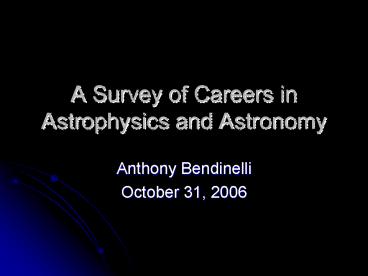A Survey of Careers in Astrophysics and Astronomy - PowerPoint PPT Presentation
1 / 13
Title:
A Survey of Careers in Astrophysics and Astronomy
Description:
... Careers in Astrophysics and Astronomy. Anthony Bendinelli. October 31, ... of astronomy Ph.D.'s accept a ... to Discover: A Guide to Careers in Astronomy' ... – PowerPoint PPT presentation
Number of Views:181
Avg rating:3.0/5.0
Title: A Survey of Careers in Astrophysics and Astronomy
1
A Survey of Careers in Astrophysics and Astronomy
- Anthony Bendinelli
- October 31, 2006
2
Studying Astronomy
- Typical courseload
- Mechanics, quantum physics, electrodynamics
- Other courses structured for astronomy
- Stellar evolution, cosmology, computational
methods - Two years of classwork
3
Getting the Degree
- Masters degree often follows coursework
- Ph.D. requires 2-4 years
- Dissertation
- Theory Writing computer code, simulations
- Observation Analyzing data but can be subject
to delays (e.g. weather)
4
Employment Options
- Astronomical Research
- Postdoctoral Appointments
- Private Industry
- Museums/Planetariums
- Public Relations/Journalism
5
Astronomical Research
- Recent Job Postings (as of 10/06)
- Telescope Systems Engineer
- Massive Star Post-Doctoral Researcher
- Astronomical Programmers
- Observatories/Research Centers
- Hubble Space Telescope
- New Mexico, Chile, Puerto Rico
6
Postdoctoral Appointments
- ¾ of astronomy Ph.D.s accept a postdoc
appointment - Many more job offers, but a lot more applicants
- Typical length of employment is 2-6 years
- Geography issues
- Median salary 42,000
7
Private Industry
- Software Writing
- Fast-growing field
- Mathematical Modeling
- Financial Sectors
- Meteorology
- Material Sciences
- Telecommunications
8
Other Career Choices
- Museums/Planetariums
- Focusing more on education than research
- Requires good communication skills
- Designing digital planetariums
- Public Relations/Journalism
- Dealing with politicians
- Writing for popular scientific magazines
- Explaining NASA missions to the public
9
Things You Might Not Know
- Typical salary (professors) 50-100k
- Small field of professionals
- 7000 astronomers, 40,000 physicists
- Often flexible scheduling
- Employment rate gt 90
- Permanent jobs, however, may be difficult to find
10
Resources
- American Astronomical Society www.aas.org
- Career Services
- American Institute of Physics www.aip.org
- Occupational Information Network
http//online.onetcenter.org
11
Final Thoughts
- Perhaps you will be smart, or lucky, enough to
stay in academia for the rest of your working
career but perhaps you will not. Some time
spent thinking about other career paths will not
be wasted. An academic career may not be the bed
of roses that you expect, and your skills (many
of which you may not realise that you possess)
will enable you to perform a wide range of jobs
outside academia. At least you will be better
prepared for the options that are available and
will be in a position to make an informed choice
of career. - - Andrew Loan, Ph.D.
12
References
- A New Universe to Discover A Guide to Careers
in Astronomy. lthttp//www.aas.org/education/publi
cations/careerbrochure.pdfgt - AAS Newsletter, June 2004, Issue 120.
lthttp//www.aas.org/publications/nlarchive/documen
ts/June04_Newsletter.pdfgt - AAS Job Register, October 2006.
lthttp//members.aas.org/JobReg/Jobregister.cfmgt
13
References
- Langer, Casey Mulvey, Patrick J. Initial
Employment Report Physics and Astronomy Degree
Recipients of 2002 2003, December 2005.
lthttp//www.aip.org/statistics/trends/reports/emp.
pdfgt - University College Dublin, A Rough Guide to
Science 2006-2007. lthttp//www.ucd.ie/engscience
/A_Rough_Guide_to_Science.pdfgt































